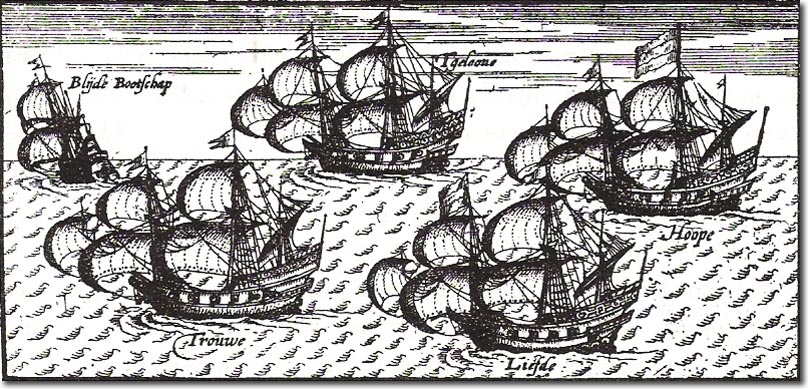|
|


|
|
William Adams was an English navigator serving with his co-religionists Dutch on a mission to find new trading opportunities in Asia.
Originally, the fleet's mission was to sail for the west coast of South America, where they would sell their cargo for silver, and to head for Japan only if the first mission failed. In that case, they were supposed to obtain silver in Japan to buy spices in the Moluccas, before heading back to Europe. The vessels, ships ranging from 75 to 250 tons and crowded with men, were driven to the coast of Guinea, West Africa where the adventurers attacked the island of Annob'n for supplies, and then moved on for the Straits of Magellan. Scattered by stress of weather and after several disasters in the South Atlantic, only three ships out of five made it through the Magellan Straits. (The Blijde Boodschap was adrift after being disabled in bad weather and was captured by the Spanish, whereas the Geloof returned to Rotterdam in July 1600 with 36 of the original 109 crew. During the voyage, William Adams had changed ships to the Liefde (originally Erasmus and adorned by a wooden Erasmus on her stern. The Liefde waited for the other ships at Floreana Island off the Chilean coast. However, only the Hoop had arrived by the spring of 1599 and the captains of both vessels, together with Adams's brother Thomas and twenty other men, lost their lives in an encounter with the natives. The Trouw later turned up in Tidore (Indonesia) where the crew was eliminated by the Portuguese in January 1601. In fear of the Spaniards, the remaining crews determined to sail across the Pacific. It was late November 1599 when the two ships sailed westwardly for Japan. On their way, the two ships made landfall in "certain islands" (possibly the islands of Hawaii) where eight sailors deserted the ships. Later during the voyage, a typhoon claimed the Hoop with all hands, in late February 1600. On April 19, 1600, after more than nineteen months at sea, the Liefde with a crew of about twenty sick and dying men (out of an initial crew of about 100) was brought to anchor off Usuki in Bungo (current Ooita prefecuture), eastern part of the Kyushu island of Japan. Its cargo consisted of eleven chests of coarse woolen cloth, glass beads, mirrors, spectacles, nails, iron, hammers, 19 bronze cannons, 5,000 cannonballs, 500 muskets, 300 chain-shot and 3 chests filled with coats of mail. When the nine crew members were strong enough to stand, they made landfall off Sashiu coast in Usuki, they were met by locals and Portuguese Jesuit priests claiming that Adams' ship was a pirate vessel and that the crew should be crucified as pirates. The ship was seized and the sickly crew were imprisoned at Osaka Castle on orders by Tokugawa Ieyasu, the daimyo of Mikawa and future Shogun. The 19 bronze cannons of the Liefde were unloaded and according to Spanish accounts later employed at the decisive Battle of Sekigahara on October 21, 1600. William Adams would go on to have a remarkable career as adviser to the victorious Shogun. He would be instrumental in helping supplant Portuguese and Catholic influence in Japan and made it possible for the Protestant nations of England and Holland to gain a foothold - even if a limited one. |
Timelines | 17th Century Timeline
Armed Forces | Art and Culture | Articles | Biographies | Colonies | Discussion | Glossary | Home | Library | Links | Map Room | Sources and Media | Science and Technology | Search | Student Zone | Timelines | TV & Film | Wargames